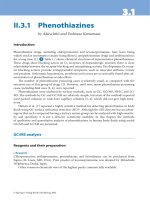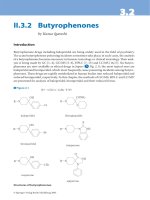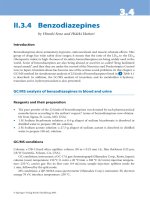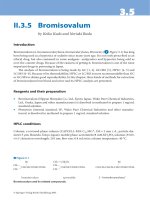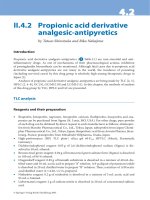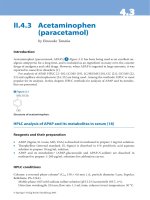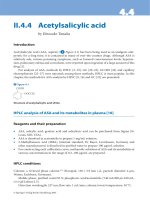Tài liệu Drugs and Poisons in Humans - A Handbook of Practical Analysis (Part 5) doc
Bạn đang xem bản rút gọn của tài liệu. Xem và tải ngay bản đầy đủ của tài liệu tại đây (244.88 KB, 11 trang )
5
© Springer-Verlag Berlin Heidelberg 2005
I.5 Detection methods
By Osamu Suzuki
Introduction
e advancement of technologies was marvelous during the past half century; new analytical
instruments have been being invented and improved. About 30 years ago, thin-layer chroma-
tography (TLC) was being used most widely for detection and identi cation of drugs and poi-
sons. Around that time, the use of GC/MS started in the eld of medicine. erefore, an ideal
procedure for analysis of drugs and poisons was considered to be the screening by TLC, fol-
lowed by the nal identi cation and quantitation by GC/MS.
However, recently, various enzyme immunoassays for drugs without need of pretreatments
have appeared, and some disposable drug screening kits have become available, resulting in a
great change of analytical procedure for unknown toxins in human samples.
> Figure 5.1
shows a owchart of the current analytical procedure for human specimens. For the details of
⊡ Fig. 5.1
Flowchart of analytical methods for drugs and poisons.
34 Detection methods
preliminary spot or color tests, the readers can refer to a new book [1], which has been pub-
lished very recently.
Thin-layer chromatography (TLC)
TLC is a method of chromatography in which a thin-layer made of silica gel, alumina, orisil
or cellulose is coated on glass or aluminum plates. Numerous types of TLC ready for use with-
out the need of pretreatments are commercially available.
An extract uids is spotted onto a bottom area of a plate. A er drying the spot, the plate is
developed with a mobile phase consisting of various ratios of organic solvents, acids and/or
water. During the development with a mobile phase, a compound spotted moves at a certain
speed towards the top. e movement of a compound to be analyzed is usually expressed by R
f
values (distance which a compound travels from the origin/distance which a solvent front
travels from the origin).
is method requires no expensive instruments and is very simple. Since relatively many
samples can be analyzed by this method in several hours, it is widely used as a simple method
for detection and tentative identi cation of drugs. For detecting each spot, a reagent solution
specially prepared can be sprayed on the plate to detect a compound speci cally. e details of
the TLC method are well described in many books of forensic and analytical chemistry [2, 3];
the speci c reagents to be sprayed are also described [4, 5].
e spots separated and detected by TLC can be quantitated to some extent (semiquantita-
tively) by a densitometer; the detection limits are several ten ng to several µg on a plate.
Recently, TLC plates coated by stationary phases with small and uniform particles
(4.5–5 µm diameter) have became commercially available [6]; these plates are superior in sep-
aration ability and requires shorter times for development. ey are being called “ high-per-
formance TLC ( HPTLC)”.
Spectrophotometric and fluorescence analysis
A spectrophotometer and a uorophotometer (spectro uorophotometer) are very common
analytical instruments equipped at almost every chemical or biochemical laboratory. With
spectrophotometers, the absorption of ultraviolet and/or visible light can be measured. e
detection limits are usually several µg/mL by spectrophotometry and about several ten ng/mL
by uorophotometry. Each spectrum of compounds can be recorded for tentative identi ca-
tion by both methods, but only with the spectra of compounds, the nal identi cation cannot
be achieved.
e spectrophotometer and uorophotometer are also useful as detectors in high-perform-
ance liquid chromatography (HPLC); in these cases, the detectors are simpli ed and downsized.
Infrared absorption spectroscopy
When a molecule is irradiated by an infrared light beam, a certain rotation or vibration takes
place depending on the nature of a molecule. Infrared absorption occurs only when a change
35
in dipole moment takes place. e conventional dispersive type of the spectrometer gives low
sensitivity and requires several ten µg to several mg of a pure compound for measurements. By
comparing the absorption spectra, the con rmation of identity can be achieved for a known
compound; estimation of particular bonds and functional groups may be possible for an un-
known compound.
e conventional dispersive type of the instrument was high-powered by changing optic
structures and by using a computer system to construct the Fourier transform infrared spec-
trophotometer (FT-IR). e instrument is as expensive as a mass spectrometer. By increasing
the scan number and by shortening the scan time, FT-IR can be connected with GC and HPLC.
However, in toxicological analysis, FT-IR does not seem superior to mass spectrometry.
Radio- and enzyme-immunoassays and fluoroimmunoassays
Radioimmunoassays (RIA) are based on the competition of a drug in a specimen with its
radiolabelled one for binding sites of a speci c antibody, which had been prepared previously.
e sensitivity of RIA is usually very high with detection limits of pg to ng levels.
e basic principle of the enzyme-immunoassays ( ELISA) is the same as that of RIA. ELISA
employs an enzyme linked to a drug as a marker in place of radioisotopes. e tests can be
performed at any laboratory without any licence for radioactive compounds. e recent prod-
ucts of ELISA have sensitivity and speci city comparable to those of RIA. In the sandwich
ELISA method, the primary antibody xed to a plate and the secondary antibody labeled with
an enzyme marker are employed. e antigen (drugs or poisons) is bound between the two
antibodies.
One of the uoroimmunoassays is based on the di erence in polarization between the
bound and free forms of a uorophore-labelled drug observable during the antigen-antibody
reaction. Although this method is simple, the sensitivity is not so high.
In all of the above immunoassays, antibodies speci c to drugs or poisons should be pre-
pared in advance. ere is a disadvantage of cross reactions among drugs of similar structures.
However, when once the method is established for a drug as a kit, a crude biological specimen
can be analyzed without any extraction or puri cation; it is quite useful for screening or as a
preliminary test.
Now, immunoassay kits are commercially available from manufacturers in U.S.A. and
Europe for amphetamines, antiepileptics, antiarrhythmics, cardiac glycosides, antibiotics,
bronchodilating agents, anticarcinogens, antipyretic-analgesics and immuno-suppresives.
Recently, a disposable kit Triage
®
is being widely used to screen drugs of abuse and their
metabolites in urine; this kit is also based on an immunoassay using gold colloid particles. It
can qualitatively detect benzodiazepines, cocaine metabolites, amphetamines, a cannabinoid
metabolite, opiates, phencyclidine and tricyclic antidepressants in only about 10 min. Some
similar kits are being sold in U.S.A. and Europe. e situation of widely used or abused drugs
is di erent according to countries. Abusing cases with phencyclidine are very rare in Japan,
while the cases with phenothiazines, bromisovalum and acetaminophen are very common.
e development of an immunoassay screening kit covering the above drugs widely used in
Japan is being awaited.
Radio- and enzyme-immunoassays and fl uoroimmunoassays
36 Detection methods
Gas chromatography ( GC)
GC was previously called “gas-liquid chromatography”. It is based on separation by partition
between gaseous and liquid phases for vaporized compounds owing together with a carrier
gas (N
2
or He) inside a GC column at relatively high temperatures. erefore, GC is not suita-
ble for analysis of non-volatile or thermolabile compounds, but is superior in separation abil-
ity, because of the high number of theoretical plates; the reproducibility of the method is excel-
lent, because of the simple structure of the instrument. GC is now being indispensable for drug
analysis.
GC columns
e conventional packed column is prepared by introducing a packing material into a glass
column with internal diameter of 2–3 mm and with length of several meters. e packing ma-
terials is prepared by well mixing an inert granular support with an oily liquid phase. e kinds
of both supports and liquid phases are numerous; the most suitable ones can be chosen from
many.
Recently, fused silica capillary columns are far more popular than the packed columns. e
former columns are open-tubular and several ten meters long; carrier gas can ow fast through
them. A liquid phase of 0.1–2.0 µm thickness is coated on the inside-surface of each column.
ere are three types of capillary columns according to the size of their internal diameter; nar-
row-bore columns for 0.1–0.18 mm, medium-bore columns for 0.25–0.32 mm and wide-bore
columns for 0.53–0.72 mm.
e capillary columns give better separation and less adsorption of analytes than
the packed columns, resulting in the appearance of sharp and symmetrical peaks with
high sensitivity. As liquid phases, non-polar dimethylsilicone, slightly polar 5% phenylsili-
cone/95% dimethylsilicone, intermediately polar 50% phenylsilicone/50% dimethylsilicone
and highly polar polyethylene glycol are being used. Even for compounds, which give no
peaks with packed columns, their peaks can be detected with capillary columns in many
cases.
e wide-bore capillary column is useful, when a relatively large amount of gas has to be
injected without splitting; it can be used for alcohol analysis in combination with the head-
space method. Since the gas ow inside the wide-bore column is fast, and thus the time for
exposure to heat is short, the column is sometimes suitable for analysis of relatively thermola-
bile compounds such as benzodiazepines.
Since the gas ow rate for a medium-bore capillary column is usually several mL/min,
1–2 µL of an organic solvent extract to be injected should be split prior to its introduction into
the column; this means that only less than 10% of the entire sample volume injected is detected,
resulting in lowered sensitivity. However, about ten years ago, an automatic switching device
between the splitless and split modes became very popular for new types of GC instruments.
e device made it possible to introduce an entire amount of a compound to be analyzed into
a medium-bore capillary column in the splitless mode at a relatively low column temperature
to completely trap the compound inside a front part of the column; a er changing to the split
mode, the oven temperature is elevated gradually, until a large peak due to the entire amount
of the analyte appears.
37
Cryogenic oven trapping GC
A microcomputer controlling cryogenic oven temperatures below 0° C became widely availa-
ble for modern types of GC instruments. It had been originally designed for rapid cooling of
an oven to reduce analysis time. e authors et al. [7, 8] used it to trap volatile organic com-
pounds (VOCs) contained in gas samples, and named it “ cryogenic oven trapping ( COT)”. By
use of this method, a large volume of headspace vapor (5 mL or more) can be introduced, in
the splitless mode, into a medium-bore capillary column at low oven temperatures. e proce-
dure results in trapping of VOCs inside a narrow zone of the inlet end of a cooled column
without any loss of analytes in the splitless mode (
> Figure 5.2). erefore, very sharp and big
peaks and good separation can be achieved by this method. In spite of the use of the conven-
tional ame ionization detector, the sensitivity obtained by GC-COT is 10–50 times higher
than that of the usual headspace GC. e author et al. [7] rst applied this method to sensitive
analysis of chloroform and dichloromethane and established the details of the procedure. A er
this study, we extended this line of experiments to other VOCs and got good results.
e cost of the COT device is low, and the handling of the device is so simple that no special
procedure is required during GC analysis. One disadvantage of COT with liquid CO
2
is the
possibility of CO
2
poisoning. Air containing more than 3% CO
2
was reported to be hazardous
to humans; 6–10% CO
2
is very dangerous. Such danger should be kept in mind, and laborato-
ries should be ventilated during such experiments. e consumption of the liquid CO
2
is rapid
especially for COT at very low temperatures; this means that more cost for liquid CO
2
is need-
ed for lower oven temperatures.
Structural schema of cryogenic oven trapping (COT) GC. Liquid nitrogen is vaporized in the GC
oven for cooling under the control of a microcomputer. After injection of 5 mL volume of
headspace gas, the entire amount of a target compound is trapped inside a front part of the
capillary column.
⊡ Figure 5.2
Gas chromatography ( GC)
38 Detection methods
GC detectors
e ame ionization detector ( FID) is most common for GC analysis. Every compound having
a C-H bond can be detected with the FID. At the outlet of GC ow, hydrogen gas and air are
mixed with the carrier gas and burnt in the presence of voltage; ion current due to ionized
carbon is measured. e detection limits of an FID is 1–10 ng in an injected volume.
e ame photometric detector ( FPD) is partly similar to the above FID in that a target
compound is burnt with hydrogen gas and air; however in this method, the changes in color of
the hydrogen ame are optically detected. It is sensitive and speci c for compounds containing
sulfur and phosphorus.
e electron capture detector ( ECD) utilizes β-ray irradiated from
63
Ni to detect com-
pounds containing halogen and nitro groups in their structures. e detection limits obtained
with an ECD are several pg to several ng in an injected volume.
e ame thermionic detector ( FTD) is the same as the nitrogen phosphorus detector
( NPD), and responds to nitrogen- and phosphorus-containing compounds with high sensitiv-
ity. Its detection limits are several ten pg to several ng; the sensitivity with an FTD is about ten
times lower than that with an ECD.
e surface ionization detector ( SID) was developed in Japan. It is highly sensitive and
speci c for tertiary amino compounds. Good results were obtained for analysis of tricyclic
antidepressants and diphenylmethane antihistaminics.
High-performance liquid chromatography ( HPLC)
Many years ago, more than nine million compounds were registered in the Chemical Abstracts;
among them the number of compounds analyzable by GC was said to be only 130,000 (1.4%).
It shows that the great majority (more than 98%) of the compounds are highly polar, non-vola-
tile or thermolabile. erefore, it seems correct that to analyze unknown compounds, HPLC is
more suitable than GC. In fact, the use of HPLC is increasing.
In an HPLC column, a ne particle packing material (stationary phase) is packed; a er
loading puri ed sample solution onto the column, a mixture of organic solvents and/or a bu er
solution is sent to the column. e target compound can be separated from other compounds
during passage through the column according to the di erence in ow rate for di erent com-
pounds. e separation ability of HPLC is much inferior to that of capillary GC. HPLC col-
umns can be classi ed into three groups, viz. normal phase, reversed phase and ion exchanger
columns. Among them, reversed phase columns are being used most popularly; as packing
materials, C
18
and CN groups covalently bound to support materials are being well used. As a
mobile phase, a mixture of water and methanol (or acetonitrile) is commonly used. When
octanesulfonate or heptanesulfonate is added to the mobile phase, the ion-exchanging e ects
can be added to the reversed phase HPLC, resulting in the better resolution ability of the
column. is is called “ ion-paring reversed phase HPLC” and is becoming more popular also
in analysis of drugs and poisons.
As one of the trends in HPLC, miniturization of separation columns and the related sys-
tems can be mentioned. In addition to the standard-bore columns of 3–6 mm internal diame-
ter, so-called micro-bore columns of 1.0–2.1 mm internal diameter have become used popu-
larly. Capillary HPLC columns of 0.3–0.5 mm internal diameter are also commercially availa-
39
ble. is kind of minituarization makes the volume to be injected smaller, which is eventually
related to enhancement of sensitivity, and makes the resolution ability better.
Before introduction to a separation column, a switching system consisting of a condensa-
tion column and a switching valve can be attached to an HPLC instrument. By this system, as
large as 500 µL of sample solution can be injected and sent to the separation column without
any loss of a target compound, resulting in much higher sensitivity.
As detectors for HPLC, a UV plus visible spectrophotometer and a uorophotometer are
most common. With the latter detector, several ten pg to several hundred pg of compounds can
be determined under the best instrumental conditions. Catecholomines can be detected with
an electrochemical detector of HPLC with very high sensitivity.
e HPLC sometimes su ers from shi s in retention time during repeated assays and most
seriously from the obstruction of the column. More e orts for maintenance is required for
HPLC than for GC.
Ion chromatography ( IC)
IC is a specialized type of HPLC; it is exclusively adapted for analysis of ionic compounds in-
cluding inorganic and metal compounds. e arsenic poisoning incident which took place in
Wakayama, 1998, and the following incidents with sodium azide poisoning reminded us the
importance of analysis of inorganic compounds. To analyze inorganic ions with high sensitiv-
ity, IC is now the most useful tool. However, the costs for IC instruments are much higher than
that of a usual HPLC. An IC system consists of a pump, an ion-exchange separation column,
a suppressor, a conductivity detector and a workstation for integration and data processing. For
analysis of inorganic anions and cations, anion and cation exchanger columns are used, respec-
tively.
Since the change in electric conductivity caused by a target inorganic ion is measured
by IC, high baselines and interfering peaks caused by ions being mixed in the mobile phase
become serious problems. erefore, the suppressor is essential to lower the baseline and to
stabilize it to detect a peak of the target compound with high sensitivity; it should be, of course,
located before the detector. e detection limits are several ng to several µg on-column de-
pending on the kinds of compounds to be analyzed.
Various combinations of a mobile phase with a separation column, almost every inorganic
ion (anions and cations) can be detected and quantitated. IC for inorganic ions is comparable
to HPLC for organic compounds; thus the nal identi cation cannot be achieved only by IC.
For the identi cation of inorganic ions, ICP-MS is required.
Mass spectrometry ( MS)
In the positive ion electron impact ( EI) mode of MS, a target molecule is strongly collided by
electron to yield many/some fragment ions. e positive fragment ions are accelerated in an
electric eld, introduced into a lens of an electric or magnetic eld or into an electric eld of
a quadrupole for separation according to the mass numbers of fragment ions, and nally
detected. A characteristic mass spectrum is obtained with the mass number on the horizontal
axis and bars of various intensities on the vertical axis. e EI mass spectrum shows a stereo-
Mass spectrometry ( MS)
40 Detection methods
typed pattern according to each compound under similar MS conditions; it is widely accepted
that MS is the most reliable identi cation method. When the pro le of an EI mass spectrum
obtained from a compound in a specimen coincides with that obtained from the authentic
compound, it can be almost concluded that the two compounds are identical. In the selected
ion monitoring ( SIM) mode of MS, ultra-sensitive quantitation can be realized at pg or fg levels
on-column. e magnetic sector mass spectrometer is relatively large in size and expensive. To
obtain exact mass numbers with four decimal places, high resolution mass spectrometry using
a double-focusing magnetic sector mass spectrometer is necessary. e functions of recent MS
instruments have been markedly improved; even with a low resolution mass spectrometer,
good measurements can be achieved without shi s in a mass unit. erefore, for analysis of
drugs and poisons, bench-top type quadrupole mass spectrometers, which are relatively cheap
and easy to be handled, are being used widely.
GC/MS
A mass spectrum can be obtained by the direct inlet method; in this method, an almost pure
compound should be used. When a crude extract from a human specimen is analyzed, a target
compound should be separated by chromatography before application to MS. erefore, on-line
GC/MS is usually used in such cases.
ere are 3 types of ionization in GC/MS; positive ion EI, positive ion chemical ionization
( CI) and negative ion CI modes. e positive ion EI mode is most common, standardized and
suitable for measurements of mass spectra. However, there are many cases in which molecular
ions (M
+
) cannot be obtained; the molecular weight cannot be estimated in such cases.
e positive ion CI mode is a much so er ionization method than the EI mode; the colli-
sion of electrons ionizes the reagent gas, and the ionized gas interacts with a target compound
largely to yield an intense [M+1]
+
protonated-molecular ion, which is useful for estimation of
its molecular weight.
In the negative ion CI mode, the reaction mechanisms are similar to the above positive one;
but only negative ions produced are detected. is method gives various characteristic advan-
tages; by this method, halogen group-and nitro group-containing compounds can be detected
with high sensitivity, and these groups can be easily identi ed by the presence of characteristic
peaks of halogens liberated. e method also gives characteristic base peaks for organophos-
phorus pesticides, which is very useful for both screening and sensitive quantitation by SIM.
LC/MS
e reason why on-line GC/MS was rst realized is that the connection between GC and MS
is very easy; with use of a medium-bore capillary GC column, the sample gas can be directly
introduced into an ionization chamber without use of a separator, because of its low ow-rate.
However, there were many di culties for connecting LC (HPLC) with MS until recently. Now-
adays, these problems have been overcome, and many types of on-line LC/MS instruments are
commercially available. Many reports are being published on analysis of drugs and poisons by
LC/MS. e connection device between LC and MS is called “ interface”. As interfaces, thermo-
spray, frit-fast atom bombardment, atmospheric chemical ionization ( APCI) and electrospray
41
ionization ( ESI) modes can be mentioned. Among them, ESI and APCI are being used best,
because of their high sensitivity and good quantitativeness.
LC/MS instruments have become widespread very rapidly. Many drugs and poisons in bio-
logical specimens can be identi ed and quantitated without any derivatization by this method.
e sensitivity of LC/MS has been improved and is now comparable to that of GC/MS.
MS/MS ( tandem MS)
Two MS instruments are combined; the rst MS is used for separation of compounds like GC,
and the second one is used for selective detection. Relatively crude samples with many impuri-
ties can be injected into the rst MS by the direct inlet method, and a single ion produced
is selected and introduced into the second one to collide with neutral molecules (inert gas),
resulting in product ion formation. e latter process is called “ collision induced dissociation
(CID)” and useful for identi cation and quantitation using the product ions.
GC or LC (HPLC) can be connected with MS/MS; GC/MS/MS or LC/MS/MS gives clean
product ion mass spectra without impurity peaks, and enables sensitive quantitation by selec-
ted reaction monitoring ( SRM) with very high speci city. GC/MS/MS and LC/MS/MS are now
the most powerful tools for drug and poison analysis.
As described above, the tandem type with two MS instruments is called “tandem-in-space
mode”, and is relatively expensive. Another tandem type is MS of ion trap mode; it does not
need two instruments. One MS instrument can ful ll the tandem function with a di erent
principle and with regulation by a computer; this type is called “tandem-in-time mode”, and
less expensive than the tandem-in-space MS type. Although the tandem-in-time type does not
allow the simultaneous scanning of both precursor and product ions, the sensitivity is very
high. It is said that quantitativeness of the ion trap MS is low; to achieve accurate quantitation,
the use of a stable isotopic internal standard is necessary.
Inductively coupled plasma-MS ( ICP-MS)
“Plasma” is electrically neutral but ionized gas, in which atoms moving randomly, ions and
electrons are coexisting. ICP is argon plasma, which has been excited by high frequency induc-
tion [9].
A copper wire is coiled around a discharge tube made of quartz glass, which is called
“torch”; and an electric eld is produced inside the torch by turning on the electricity through
the coil. When argon gas is introduced into the torch, the argon atoms are accelerated in the
electric eld to yield argon plasma a er repeated collisions. e temperature of the resulting
ICP is as high as 6,000–8,000 K. When a nebulized specimen is introduced into the torch to-
gether with carrier gas of argon, atoms in the specimen are excited and emit each spectrum
beam, which is speci c to an element; a part of the atoms is ionized simultaneously.
ICP emission spectrometry is a method for detecting the beam emitted by the ICP spectro-
photometrically; ICP-MS is a method for detecting the ions by MS. In ICP-MS, a quadrupole
MS instrument is usually used; many elements can be simultaneously detected with high sen-
citivity at pg/mL levels within a short time. ese ICP methods are suitable for elemental anal-
ysis of inorganic compounds and metals rather than organic compounds.
Mass spectrometry ( MS)
42 Detection methods
e mass spectrum of ICP-MS is di erent from that of usual MS for organic compounds.
It is an elemental analysis and does not show the structure of a molecule. To estimate a struc-
ture of an inorganic ion, it is recommendable to connect ion chromatography (IC) with the
ICP-MS.
> Figure 5.3 shows a characteristic ICP-mass spectrum; the horizontal axis shows
the mass number and the vertical axis the intensity of each ion of elements [10]. In the mass
spectrum for arsenic, it should be kept in mind that Ar being used as plasma gas is easily bound
with Cl to form argride ( ArCl
+
, m/z 75), which give the same mass number as that of As
+
.
Quantitative analysis can be also made by ICP-MS.
e cost for ICP-MS is as high as that of the magnetic sector mass spectrometer. IC/ICP-
MS is very useful for identi cation and quantitation of inorganic molecule, but the cost is even
higher. e IC/ICP-MS is comparabe to the LC/MS for organic compounds.
X-ray fluorescence analysis
In the X-ray uorescence analysis, the word “ uorescence” is used. However, it does not mean
the use of actual uorescence light. In the usual uorescence spectrophotometry, when an aro-
matic molecule having a conjugated double bond is irradiated by a light with a shorter wave-
length (higher energy), the molecule absorbs the light energy to be enhanced to an excited
state and emits a light with a longer wavelength (lower energy) as uorescence. A similar phe-
nomenon can be observed for other radiations; when an atom is irradiated by an X-ray, γ beam
or electron beam, an X-ray characteristic of the atom is emitted. erefore, the emitted X-ray
is called “ uorescence X-ray”.
In the X-ray uorescence analysis, elements having molecular weights not smaller than
that of Na can be easily analyzed qualitatively and quantitatively; the method is very suitable
for elemental analysis of inorganic and metal compounds. e advantage of this method is the
ability of analysis without any damage to a specimen; it is noninvasive, and the specimen, which
ICP mass spectrum for arsenic and other metals. Human nails were used for analysis. The peak at
m/z 75 is due to arsenic. The shadow peaks were obtained from a blank sample.
⊡ Figure 5.3
43
had been used for the X-ray uorescence analysis can be again used for another analysis. ere-
fore, this method is especially useful for screening of inorganic compounds (see
> Figure 5.1),
and the nal analysis can be made by IC or ICP-MS. In the curry poisoning incident in
Wakayama, arsenic could be identi ed from curry by these methods [10].
e sensitivity of the X-ray uorescence method is at µg/g levels, and the cost for the in-
strument is relatively high.
Atomic absorption spectrometry
When NaCl crystals are introduced into a ame of gas burner, the blue color of the ame
immediately changes to an orange color. By utilizing such a phenomenon, various inorganic
and metal compounds can be analyzed spectrophotometrically by burning specimens [12]. It
is especially suitable for analysis of cation metals; however, each lamp, which emits a light
showing a speci c wavelength, is necessary for each element to be analyzed.
Recently, so-called ameless atomic absorption spectrometry is being used; it does not use
ame burning, but uses a furnace of high temperature. e advantages of the ameless method
are smaller volume of specimens required and higher sensitivity.
e detection limits of atomic absorption spectrometry with ame burning are at several
µg/g levels. e pretreatments for this method are generally simple.
e method has a long history; the readers can nd the details of the method in many
books 12].
References
1) Jeffrey W (2004) Colour tests. In: Moffat AC, Osselton MD, Widdop B (eds) Clarke’s Analysis of Drugs and
Poisons, 3rd edn. Pharmaceutical Press, London
2) Yamamoto I (ed) (1998) Legal Medicine and Forensic Chemistry, 3
rd
edn. Hirokawa Publishing Co., Tokyo,
pp 121–205 (in Japanese)
3) Pharmaceutical Society of Japan (ed) (1992) Standard Method of Chemical Analysis in Poisoning – With Com-
mentary. Nanzando, Tokyo, pp 1–462 (in Japanese)
4) Dawson RMC, Elliott DC, Elliott WH et al. (1986) Data for Biochemical Research, 3
rd
edn. Clarendon Press, Oxford,
pp 453–501
5) Stevens HM (1986) Colour tests. In: Moffat AC, Jackson JV, Moss MS et al. (eds) Clarke’s Isolation and Identifica-
tion of Drugs. The Pharmaceutical Press, London, pp 128–147
6) Shinozuka T, Terada M, Ogamo A et al. (1996) Data on high-performance thin-layer chromatography of
analgesic and antipyretic drugs. Jpn J Forensic Toxicol 14:246–252
7) Watanabe K, Seno H, Ishii A et al. (1997) Capillary gas chromatography with cryogenic oven temperature for
headspace samples: analysis of chloroform or methylene chloride in whole blood. Anal Chem 69:5178–5181
8) Watanabe-Suzuki K, Ishii A, Lee X-P et al. (2000) Analysis of volatile organic compounds by cryogenic oven
trapping gas chromatography. Jpn J Forensic Toxicol 18:201–209 (in Japanese with an English abstract)
9) Osumi Y (1996) ICP (including ICP-MS). In: Izumi Y, Ogawa M, Kato S et al. (eds) Manual of Instrumental Analysis,
2nd edn., vol 3. Kagakudojin, Kyoto, pp 43–51 (in Japanese)
10) Suzuki S (2001) Analysis of poisonous materials focused on arsenous acid. Jpn J Forensic Toxicol 19:1–10 (in
Japanese with an English abstract)
11) Toda K (1996) X-ray fluorescence analysis. In: Izumi Y, Ogawa M, Kato S et al. (eds) Manual of Instrumental
Analysis, 2nd edn., vol 3. Kagakudojin, Kyoto, pp 55–72 (in Japanese)
12) Hirashima Y (1996) Atomic absorption spectrometry. In: Izumi Y, Ogawa M, Kato S et al. (eds) Manual of Instru-
mental Analysis, 2nd edn., vol 3. Kagakudojin, Kyoto, pp 19–32 (in Japanese)
Atomic absorption spectrometry
